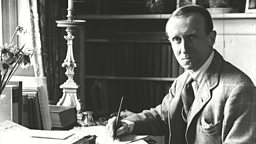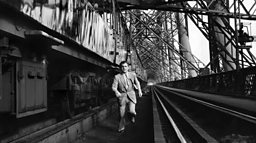The first thriller: 100 years of The Thirty-Nine Steps
By Stuart Kelly | 21 September 2015

John Buchan’s The Thirty-Nine Steps, which was published in novel rather than serial form 100 years ago, has a good claim to be the first ever thriller.
It did not arrive out of nowhere – in the third Chapter, The Adventure of the Literary Innkeeper, when the hero Richard Hannay tells a variation of his story to the said publican, Buchan pays homage to two of his precedents: “By God!” he whispered, drawing in his breath sharply, “it is all pure Rider Haggard and Conan Doyle.”
Buchan took an almost perverse delight in belittling his greatest achievements
It also has affinities with the invasion fantasies of William Le Queux and Erskine Childers, and, further back, the ‘man on the run’ theme can be found in two of Buchan’s literary heroes, Sir Walter Scott and Robert Louis Stevenson.
But there was something different about Buchan’s ‘dime novel’ or ‘shocker’ – like Grahame Greene, Buchan took an almost perverse delight in belittling his greatest achievements – and much of that has to do with the nationality of the hero.
Richard Hannay is a Scot, and, more importantly, a Scot of the British Empire. At the opening of the novel he has returned from colonial duties in South Africa and pronounces himself “pretty well disgusted with life in London”.
When the mysterious conspiracy theorist Scudder is murdered in his house, it precipitates a chain of events where Hannay, time and again, relies on his experiences as a Scot of the Empire to extricate himself. In short, Hannay is the perfect literary chameleon.
As a Scot of the Empire, Hannay is the perfect insider/outsider figure and must have had to become adept at a behavioural form of what sociolinguistics call “code-switching”. In the novel, he knows how to speak with the drunken shepherd on the train and how to speak with Sir Walter Bullivant of the Foreign Office.
The novel is remarkable in terms of the number of disguises Hannay adopts, starting with switching places with the milkman, impersonating a political candidate at a hustings, taking on the role of a road mender, donning the apparel of a fisherman. Hannay has been assuming identities all of his adult life – a Scotsman, a British official, a Westerner, a European in Africa – so doing so to save his life is second nature.
Disguise is a peculiar phenomenon in literature. Allan Quartermain, the hero of Rider Haggard’s King Solomon’s Mines, is so charismatic he couldn’t hide in a room full of Allan Quartermain impressionists. The same could be said of the ebullient and irascible Professor Challenger from Conan Doyle’s The Lost World.
Sherlock Holmes is a different proposition. We are told – and shown – that he is a master of disguise (a seaman, a groom, a Nonconformist minister, an opium addict, a common loafer, an Italian priest, a bookseller, a plumber, a dying man, an elderly huntin’-shootin’-fishin’ type and a woman is I think the whole roster).

But usually, the character who is skilled at concealing themselves is the villain, not the hero – characters like Redgauntlet in Scott’s novel of that name, or even Dr Jekyll, with his perfect disguise. We don’t trust characters who can shape-shift so effortlessly – one of the reasons Holmes is so perpetually intriguing is that the reader doesn’t really trust him. But Hannay, we do trust.
It was perhaps the very ordinariness of Hannay that endeared him to so many readers
He is, in many ways, the perfect fusion of Holmes and Quartermain. He is (a certain Scottish stereotype) the man of action, almost reckless in his physicality – throwing himself from trains and dodging biplanes. But he is also a logician (another Scottish stereotype): “I have a head for things like chess and puzzles, and I used to reckon myself pretty good at finding out cyphers”.
But Buchan adds something else. Hannay is also a technocrat. His escape from his German captors relies on his knowledge of mining explosives; it will require geography, meteorology and cartography to discover where the enigmatic Thirty-Nine Steps are.
Perhaps the most famous Scot in literature of the period was, curiously enough, in a poem by an Englishman – “McAndrew’s Hymn” by Rudyard Kipling (another author name-checked in the novel). This is the Scot as the reliable, slightly humdrum, engineer. Perhaps even more significantly, he differs from Quartermain and Holmes in another way. Both of those characters are exceptional, whereas Hannay is ordinary.
Notice, in the quote above, that he reckons himself “pretty” good – not brilliant, not daunting, not superhuman. It was perhaps the very ordinariness of Hannay that endeared him to so many readers, the readers who wrote to Buchan to say “The story is greatly appreciated in the midst of mud and rain and shells, and all that could make trench life depressing”.
At the end of the novel, Hannay is made a Captain in the First Army – not a Major or a Lieutenant Colonel. It is, certainly, higher than Buchan’s rank as a Second Lieutenant when he was in the Intelligence Corps; but Hannay is not invited into a version of the Ministry of Information or the Masterman Group on Propaganda or MI5 or MI6. Hannay’s role is characteristically modest.
In a way, Hannay’s protean, fluid identity saves the day as well as his skin. When he confronts the German saboteurs who are posing as Englishmen he realises that their impersonation is just too good – it’s interesting to compare his initial conversation with Bullivant over fly-fishing with the frostily precise manners of the villains.
Hannay, the outsider on the inside, can tell the act is done too well. This Scottishness of Hannay has been picked up in the many adaptations – think of the use of the Forth Rail Bridge in the 1959 film, or the use of Stirling Castle in the 2008 BBC adaptation.
There is one wholehearted tribute to Hannay, and Hannay’s chameleon Scottishness: James Bond. In You Only Live Twice we learn that this quintessential Englishman is half Scottish and half Swiss, and that after being sent down from Eton after some incident with the maids, he is educated in Edinburgh at Fettes College. To look at Ian Fleming’s sketch of Bond, it is hard not to see Hannay.

Seven facts about the novel
- The original title of The Thirty-nine Steps was to be The Kennels of War
- The espionage unit who are trying to kill Karolides of Greece are called the Black Stone. Gavrilo Princep, who assassinated Archduke Franz Ferdinand, was in a gang called the Black Hand.
- It is dedicated to Tommy Nelson, Buchan's publisher, who died in 1915.
- Buchan wrote an official history of the Great War in monthly form.
- Buchan was suffering from an ulcer when he wrote it. Apparently he had read all the books in the house and needed something to read.
- The 'real' 39 Steps in Broadstairs were demolished, and the final step sent to Buchan with a plaque.
- Hannay would take on the Germans again in Greenmantle. The other Hannay books pit him against organised crime.
-
![]()
Free Thinking: The Thirty-Nine Steps and WW1
Matthew Sweet investigates the connections between the novel and Buchan's own war experience.

